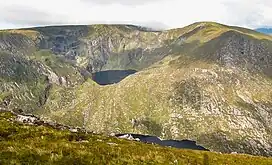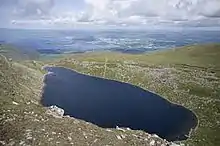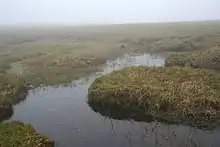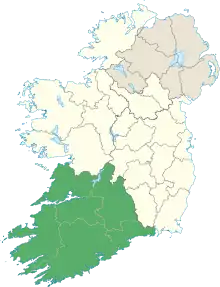Mangerton Mountain
Mangerton or Mangerton Mountain (Irish: An Mhangarta, meaning 'the long-haired (mountain)'), at 838 metres (2,749 ft), is the 19th-highest peak in Ireland on the Arderin list, and the 26th–highest mountain according to the Vandeleur-Lynam list. Mangerton is the tallest mountain in the Mangerton Mountain Group, also called the Mangerton Mountains or the Mountains of East Kerry, a range that includes five other major mountains that have a height above 2,000 feet (610 m). Mangerton's western slopes lie within the Killarney National Park. On Mangerton's north-western face lies a deep corrie lake called the Devil's Punchbowl, which is a popular scenic destination for hill walkers; although the mountain is often overlooked by walkers due to the proximity of its more scenic and accessible neighbour, Torc Mountain. The far northern slopes of Mangerton was the site of an important 13th-century battle between the Mac Cárthaigh (Gaelic forces), and the FitzGeralds (Norman forces), known as the "Tooreencormick battle site".
| Mangerton (and Mangerton Mountain Group) | |
|---|---|
| An Mhangarta | |
 Mangerton (c) with the hanging lake of Lough Erhogh (c) and Mangerton North Top (r) | |
| Highest point | |
| Elevation | 838.2 m (2,750 ft)[1] |
| Prominence | 583 m (1,913 ft)[1] |
| Listing | Marilyn, Hewitt, Arderin, Simm, Vandeleur-Lynam |
| Coordinates | 51°58′13″N 9°29′04″W[1] |
| Naming | |
| English translation | long haired (mountain) |
| Language of name | Irish |
| Geography | |
 Mangerton (and Mangerton Mountain Group) Location in Ireland | |
| Location | County Kerry, Republic of Ireland |
| Parent range | Mangerton Mountain Group |
| OSI/OSNI grid | V980807 |
| Topo map | OSi Discovery 78[1] |
| Geology | |
| Age of rock | Devonian[1] |
| Mountain type | Green sandstone & purple siltstone[1] |
| Climbing | |
| Easiest route | Devil's Punchbowl |
Naming
Irish academic Paul Tempan notes in the Irish Hill and Mountain Names database that Mangerton is most likely a translation of Irish: An Mhangarta, meaning "the long-haired".[2] Tempan discussed the possibility that an alternative interpretation of Irish: An Mhangartach may be worth considering, as it could be the noun Irish: mangart with the suffix ach. Tempan notes P. S. Dinneen's Foclóir Gaedhilge agus Béarla—Irish-English Dictionary (1927), defines Irish: mangart as "movement" or "shaking". Thus the adjective (not listed in any dictionary) could mean "moving", "shaking", or "quaking", which could refer to the physical movement of Mangerton bog prevalent on the southern slopes, or could be understood figuratively as meaning "vacillating" or "fickle".[2][3]
Geography
Mangerton

Mangerton's flat boggy summit plateau includes the satellite summits of Mangerton North Top 782 metres (2,566 ft) and Glencappul Top 700 metres (2,300 ft), and its "horseshoe-shaped" massif includes the summit of Stoompa 705 metres (2,313 ft).[4] The Horses' Glen (or Glencappul), and the Devil's Punchbowl carve deep hollows, or corries on the north-west and north-east sides of Mangerton's massif, but the southern flanks form a huge plateau, one of the most extensive areas of mountain wilderness in Ireland, where herds of red deer and sika deer still roam.[2]
There are three lochs that flow from Managerton's corries into the Horse's Glen (or Glencappul), namely the lowest, Lough Garagarry (Loch Garaigre), the middle, Lough Mannagh (Loch Meáin) and the Lough Erhogh, which is a hanging glacial lake set into a corrie on Mangerton's north-east face.[4]

The Devil's Punchbowl (Irish: Poll Ifrinn),[lower-alpha 1] at 670 metres (2,200 ft) on Mangerton's north-west face is a deep oval-shaped corrie filled by a loch in its base that drains into the Owengarriff River from which Torc Waterfall is formed, before finally flowing into the Lakes of Killarney below.[1][4] Mangerton's western slopes lie within the Killarney National Park.[7]
Mangerton Mountain's height and topographic prominence, qualifies it to meet the British Isles Marilyn classification, as well as the Arderin, Simm and Hewitt classifications.[8] Mangerton Mountain ranks as the 10th-highest mountain in Ireland on the MountainViews Online Database, 100 Highest Irish Mountains, where the prominence threshold is over 100 metres (e.g. higher mountains with sub-100-metre prominences are excluded).[9][10]
Range
Surrounding Mangerton are 25 other peaks with an elevation above 100 metres (330 ft) in a range known as the Mangerton Group (or Mangerton Mountains). The range is bounded by the "square" road system surrounding Mangerton, being the N71 to the north and the west side, the N22 to the east side, and the narrow R569 road from Kenmare to the N22 via Kilgarvan on the south side. Most notable are Dromderalough (650 metres (2,130 ft)), and its slightly higher Dromderalough North-East Top (654 metres (2,146 ft)), as well as Crohane (650 metres (2,130 ft)), and Knockbrack (610 metres (2,000 ft)). It also includes the tourist peak of Torc Mountain 535 metres (1,755 ft) in the north-west corner.[10]
Hill walking

Mangerton's flat boggy summit plateau means that it can get overlooked when guidebooks of Ireland's best walks are compiled, particularly given its proximity to the rocky ridges and summits of the MacGillycuddy's Reeks; sometimes even nearby Torc Mountain is recommended instead.[11] However, Mangerton's scale, summit views and deep corries are well regarded, and its proximity to Killarney town and ease of access are recognised by climbers.[6]
The most direct route to the summit of Mangerton is via the 4–5 hour 10-kilometre (6.2 mi) Devil's Punchbowl Route.[12] It starts from the concrete slab bridge (at V984847), and follows a worn track southwards up to the Devil's Punchbowl at 670 metres (2,200 ft), before reaching the Mangerton summit plateau via the west ridge of the Punchbowl, and then walking circa 300 metres across the plateau to the true summit of Mangerton itself, before returning via the same route (or taking the steeper eastern arete of the Punchbowl). The summit plateau of Mangerton can be difficult to navigate in poor or misty weather as there are few features.[6][13]
A variation of the Devil's Punchbowl Route is the inclusion of Stoompa, in a 5–6 hour 13.5-kilometre (8.4 mi) route, that can either be done as an extension of the Devil's Punchbowl route (e.g. over and back from Mangerton's summit to Stoopma),[4] or as a "horseshoe" or "loop-route" that starts up the Devil's Punchbowl on the westside but finishes by descending down the northern slopes of Stoompa on the eastside.[14][15]
Tooreencormick battle site
_Killarney.jpg.webp)
The far northern slope of Mangerton was the site of a battle in 1262 between the Mac Cárthaigh (Gaelic forces, being the Kingdom of Desmond) and the FitzGeralds (Anglo-Norman forces, being the Geraldines), following the rout at the Battle of Callann Glen near Kilgarvan the previous year.[2] The battle site is marked on the ordnance maps and also by a commemorative stone monument, and is known as Tooreencormick (Irish: Tuairín Cormaic, meaning 'little field of Cormac')[16] after Cormac MacCarthy Reagh, who was killed during the clash (his brother Fínghin Mac Carthaigh had been killed at the Battle of Callann). Other notable knights including Gerald Roche, "the third best baron in Erin", were slain at Tooreencormick.[17] Despite the losses, the battle is considered a MacCarthy success as the Anglo-Normans were kept out of South Kerry and West Cork (i.e. the Kingdom of Desmond), for the next three centuries.[2][4][17]
In spite of such two-edged victories, the battle of Callann and Tuairin Cormaic, for good or for evil, effectually prevented the establishment of an Anglo-Norman rule in [The Kingdom of] Desmond. It is that owing to dissensions among the Irish tribes the earls of Desmond eventually ' overtopped them all ', but in the region from which they drew their title they had more of the character of a Celtic chief than of a feudal lord, and it was left to the more resolute Tudor statesman and ruthless Tudor generals to break down the clan-system there.
— Henry Orphan, Ireland under the Normans 1169–1216 (1911)[17]
List of peaks
The MountainViews Online Database lists 26 Mangerton Mountain Group peaks more than 100 metres (330 ft) in height.[1]
| Height rank |
Prom. rank |
Name | Irish name (if different) |
Translation | Height (m) |
Prom. (m) |
Height (ft) |
Prom. (ft) |
Topo. map |
OSI Grid Reference |
|---|---|---|---|---|---|---|---|---|---|---|
| 1 | 1 | Mangerton | An Mhangara | The long-haired | 838 | 583 | 2,750 | 1,913 | 78 | V980808 |
| 2 | 12 | Mangerton North Top | — | — | 782 | 67 | 2,566 | 220 | 78 | V984818 |
| 3 | 11 | Stoompa | Stumpa | Stump | 705 | 90 | 2,313 | 295 | 79 | W006817 |
| 4 | 25 | Glencappul Top | — | Horse's Glen | 700 | 12 | 2,297 | 39 | 78 | V991819 |
| 5 | 20 | Dromderalough North-East Top[lower-alpha 2] | — | — | 654 | 29 | 2,146 | 95 | 78 | V969796 |
| 6 | 2 | Crohane | An Cruachán | Little stack[lower-alpha 3] | 650 | 385 | 2,133 | 1,263 | 79 | W050829 |
| 7 | 15 | Dromderalough | Drom idir Dhá Loch | Ridge between two lakes[lower-alpha 4] | 650 | 45 | 2,133 | 148 | 78 | V961790 |
| 8 | 26 | Dromderalough North-West Top | — | — | 625 | 12 | 2,051 | 39 | 78 | V956792 |
| 9 | 16 | Knockbrack | Cnoc Breac | Speckled hill | 610 | 45 | 2,001 | 148 | 78 | V953779 |
| 10 | 22 | Stoompa East Top | — | — | 608 | 23 | 1,995 | 75 | 79 | W018819 |
| 11 | 4 | Peakeen Mountain[lower-alpha 5] | Péicín | Boundary marker | 555 | 280 | 1,820 | 919 | 78 | V903765 |
| 12 | 13 | Knockrower | Cnoc Ramhar | Fat hill | 554 | 59 | 1,818 | 194 | 78 | V937785 |
| 13 | 10 | Peakeen Mountain West Top | — | — | 539 | 93 | 1,767 | 305 | 78 | V890765 |
| 14 | 3 | Torc Mountain | Sliabh Torc | Mountain of wild boar[lower-alpha 6] | 535 | 300 | 1,755 | 984 | 78 | V955839 |
| 15 | 23 | Peakeen Mountain Far North-West Top | — | — | 526 | 22 | 1,724 | 73 | 78 | V888769 |
| 16 | 24 | Peakeen Mountain North-West Top | — | — | 523 | 17 | 1,715 | 56 | 78 | V889766 |
| 17 | 6 | Knockanaguish | Cnoc an Uaignis | Hill of the solitude | 509 | 178 | 1,670 | 584 | 78 | V919768 |
| 18 | 8 | Derrygarriff | Doire Gharbh[lower-alpha 7] | Rough (oak) grove | 492 | 128 | 1,614 | 420 | 78 | V872774 |
| 19 | 18 | Crohane SW Top | — | — | 477 | 32 | 1,565 | 105 | 79 | W043821 |
| 20 | 19 | Torc Mountain West Top | — | — | 470 | 32 | 1,542 | 105 | 78 | V950837 |
| 21 | 7 | Bennaunmore[lower-alpha 8] | An Beannán Mór | The big (little) peak | 454 | 149 | 1,490 | 489 | 79 | W034819 |
| 22 | 14 | Carrigawaddra | Carraig an Mhadra | The dog's rock | 425 | 50 | 1,394 | 164 | 79 | W060820 |
| 23 | 17 | Foardal | An Fordal | pass gap; wandering[lower-alpha 9] | 410 | 36 | 1,344 | 118 | 78 | V885781 |
| 24 | 5 | Esknabrock | Eisc na mBroc | Ravine of badgers | 406 | 251 | 1,332 | 823 | 79 | W027772 |
| 25 | 21 | Shaking Rock[lower-alpha 10] | — | — | 402 | 27 | 1,319 | 89 | 78 | V928793 |
| 26 | 9 | Inchimore | An Inse Mhór | Big river-meadow | 256 | 100 | 840 | 328 | 78 | V922737 |
See also
Notes
- The name is associated with a legend regarding the local Chieftain O'Donoghue.[5] Chieftain O'Donoghue Ross dined with the devil on Mangerton. During an argument that developed, the chieftain punched the devil in the face and ran off down the mountain. The devil bit a chunk out of the summit and threw it after him. He missed, and it landed in Muckross Lake to form Devil's Island.[6]
- This peak is slightly higher than Dromderalough itself; Previously called Glencappul SE Top in the MountainViews Online Database.
- Paul Tempan notes: This peak has the classic hay-stack shape which is typical of mountains whose names in cruach/cruachán. Near Lough Nabroda are some crags with rhyolite formations which, though less spectacular, resemble the organ pipe formations at the Giant's Causeway.[2]
- Paul Tempan notes: The lakes are more distinctive landmarks than the hills hereabouts. The name is only recorded in English, but probably has the same origin as the townland of Dromdiralough, which is a few kilometres to the NE near Lough Guitane.[2]
- Paul Tempan notes: There is no Irish given on the Discovery map for this name, although two other peaks are named Péicín, possibly erroneously. Also known as Kilcurrane.[2]
- Paul Tempan notes: The name of Torc Mountain, like Mount Eagle and the Wolf's Step on the Dingle Peninsula, reminds us of a wild animal once common in the forests of Ireland. Wild boar is significant in Celtic mythology, being depicted on Celtic artefacts found in continental Europe, Ireland and Britain. It represents physical strength and heroic fighting skills.[2]
- Paul Tempan notes: There is a mapping problem regarding the names of several peaks in this area in that the Irish and English names are not matched up. The Irish version of Derrygarriff is given as Péicín, but this name clearly belongs to Peakeen Mountain. The correct Irish version is Doire Gharbh, which has been assigned (erroneously?) on the 1:25,000 map to the lower peak between Moll's Gap and Lough Barfinnihy.[2]
- Paul Tempan notes:On the east side an old pilgrimage path leading to Gougane Barra passes some columns of rock similar to "the Organ" at the Giant's Causeway. Bennaunmore is a remnant of an old volcano.[2]
- Paul Tempan notes: Foardal is a townland in the parish of Knockane. A pass near here called Mameordile or Mamanordill is a feature on the boundary of the baronies of Glanarought and Dunkerron as described in the Civil Survey of 1654-56. This name seems to be related to Ir. Fordal and appears to refer neither Moll's Gap nor Windy Gap, but to a pass between these two places. If so, it is not a pass which is in use now. This is perhaps unsurprising, given the boggy terrain around the Glas Loughs, and if the name Fordal means 'wandering, going astray', it may indicate that it was never considered a particularly useful route.[2]
- Paul Tempan notes: The name refers to a delicately balanced boulder which is near the summit of this peak.[2]
References
- "Mangerton Mountain". MountainViews Online Database. Retrieved 11 July 2019.
- Tempan, Paul (February 2012). "Irish Hill and Mountain Names" (PDF). MountainViews.ie. Retrieved 26 December 2018.
- Paul Tempan (Queen's University Belfast) (2005). "Some notes on the names of six Kerry mountains". Journal of the Kerry Archaeological Historical Society (JKAHS). 5 (2): 5–19.
The names of six major Kerry mountains (Mount Brandon, Beenoskee, Mangerton, Purple Mountain, Carrauntoohil, and Coomacarrea) are considered, from the point of view both of a hill-walker and of a toponymist. Difficulties of interpretation are discussed, and some tentative solutions are offered.
- Hendroff, Adrian (16 March 2015). Killarney to Valentia Island – A Walking Guide. Collins Press. ISBN 978-1848892323.
Route 28: Mangerton Mountain and Stoompa
- Crofton Crocker, Thomas (1906). "The Legend of O'Donoghue – Fairy Legends of Ireland". LibraryIreland. Retrieved 26 December 2018.
- Doherty, Tony (6 December 2008). "Take a hearty sup from the Devil's Punchbowl". Irish Times. Retrieved 26 December 2018.
- O'Dwyer, John (7 September 2016). "Walk for the weekend: Mangerton's secretive heights". Irish Times. Retrieved 26 December 2018.
The spectacular vistas from the highest point in Killarney National Park have to be earned.
- Cocker, Chris; Jackson, Graham (2018). "The Database of British and Irish Hills". Database of British and Irish Hills. Retrieved 26 December 2018.
- "Irish Highest 100: The highest 100 Irish mountains with a prominence of +100m". MountainViews Online Database. September 2018. Retrieved 26 December 2018.
- Mountainviews, (September 2013), "A Guide to Ireland's Mountain Summits: The Vandeleur-Lynams & the Arderins", Collins Books, Cork, ISBN 978-1-84889-164-7
- Fairbairn, Helen (2014). Ireland's Best Walks: A Walking Guide. Collins Press. ISBN 978-1848892118.
Route 46: Torc Mountain
- "Mangerton Mountain Walking Route to Summit, Killarney, Kerry". ActiveMe.ie. Retrieved 23 December 2018.
- Ryan, Jim (1 October 2012). Scenic Walks in Killarney. Collins Press. ISBN 978-1848891463.
Walk 15: Mangerton Mountain Circuit (10 km)
- "Mangerton and Stoompa Mtns Loop Walk Route, Killarney, Kerry". ActiveMe.ie. Retrieved 26 December 2018.
- "Mangerton / Stoompa – Hillwalk". Corkbackpackers.ie. 9 April 2017. Retrieved 26 December 2018.
This is a strenuous 5 hour (13.5 km) walking route to the peaks of both Mangerton (839m) and Stoompa Mountain (705m) taking in the Devils Punchbowl, Horses Glen and the Tooreencormick Battle Field Site. The walk has spectacular views of the Devil's Punchbowl, MacGillycuddy's Reeks, Horses Glen, Killarney National Park and on a good day south-west to Kenmare Bay.
- "Tuairín Chormaic : Tooreencormack". Placenames Database of Ireland. Retrieved 11 April 2020.
- Goddard Orphan, Henry (1911). Ireland under the Normans 1169-1216. Oxford : Clarendon Press. pp. 142–143. Retrieved 26 December 2018.
In 1262, joined by Walter de Burgh with a feudal army and ' a great number of the Irish ', he advanced into Desmond to give battle to Cormac, Fineen's brother, and avenge the slaughter of Callann. The opposing forces met on the slopes of Mangerton, at a place henceforth known as Tuairin Cormaic. Here Gerald Roche, ' the third best baron in Erin ', was slain, but this, we are told, was ' joy with sorrow to Desmond', for Cormac, son of Donnell Got, was slain on the same day, and great losses were suffered on both sides.'
Bibliography
- Dillion, Paddy (1993). The Mountains of Ireland: A Guide to Walking the Summits. Cicerone. ISBN 978-1852841102.
- Fairbairn, Helen (2014). Ireland's Best Walks: A Walking Guide. Collins Press. ISBN 978-1848892118.
- Ryan, Jim (2006). Carrauntoohil and MacGillycuddy's Reeks: A Walking Guide to Ireland's Highest Mountains. Collins Press. ISBN 978-1905172337.
- Stewart, Simon (2013). A Guide to Ireland's Mountain Summits: The Vandeleur-Lynams & the Arderins. Collins Books. ISBN 978-1-84889-164-7.
External links
- MountainViews: The Irish Mountain Website Mangerton
- The Database of British and Irish Hills , the largest database of British Isles mountains ("DoBIH")
- Hill Bagging UK & Ireland, the searchable interface for the DoBIH
- Ordnance Survey Ireland ("OSI") Online Map Viewer

